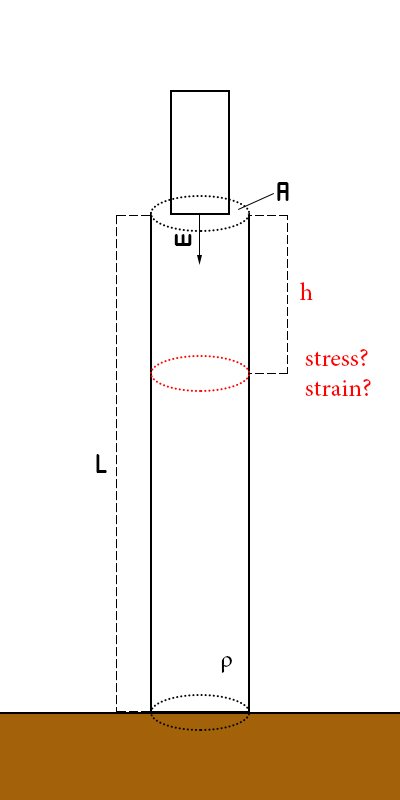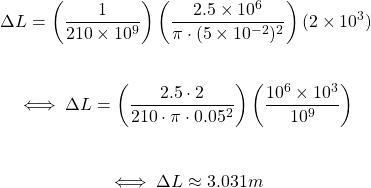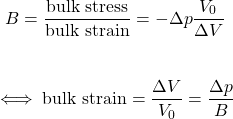Physics - Classical Mechanics - Exercises on Elasticity & Plasticity

[Custom Thumbnail that contains Image1]
Introduction
Hey it's a me again @drifter1! Today we continue with Physics, and more specifically the branch of "Classical Mechanics". Today marks the end of the chapter about Equilibrium and Elasticity. This final article will contain Exercises on Elasticity and Plasticity. So, without further ado, let's get straight into it!
Tensile and Compressive Stress & Strain
Compressive Stress in a Pillar (based on Example 12.7 of Reference 1)
Let's consider a vertical pillar of length L, cross-sectional area A and mass density ρ. On top of it rests a sculpture of weight w.
Find the equation that describes the compressive stress at the cross-section located h (< L) below the top of the pillar, as well as the compressive strain of the top h-segment of the pillar.

[Custom Figure]
Solution
The total force that acts upon the h-segment is equal to the sum of the weight of the sculpture and weight of the pillar segment above the cross-section.
To calculate the weight of the pillar segment, we first have to calculate the volume of the pillar segment and its mass.

Thus, the weight of the pillar segment is:

The total normal force acting on the cross-section located h m below the sculpture is:

The compressive stress is equal to the division of the normal force by the cross-sectional area A:

The compressive strain can be found using Young's Modulus Y for the specific material, and is equal to the division of the stress by Y:

From the results we conclude that the normal force acting on the cross-sectional area is not constant along its length, but increasing as the height of the segment h increases.
Therefore, the stress is larger at the base of the pillar, and smaller at the top.
Suspension Cable Stretching (based on Example 1 of Reference 2)
Consider a suspension cable that is used to carry gondolas at ski resorts of length L. Assume that the diameter of the cable is d = 2r and the maximum tension it can withstand is T.
Calculate the maximum stretch of the cable.
Solution
To calculate the maximum stretch we apply a force equal to the maximum tension, F = T.
The cross-sectional area of the cable is:

To calculate the change in length (or stretch in our case) we use Hooke's Law combined with Young's Modulus:

Arithmetic Example
Let's suppose that the initial length of the cable is L0 = 2 Km, the radius is r = 5 cm, the maximum tension is T = 2.5 × 106 N, and the cable is made out of steel.Young's Modulus for steel is: 210 × 109 N/m2.
Thus, the maximum stretch is:

Bulk/Volumetric Stress & Strain
Hydraulic Press (based on Example 12.9 of Reference 1)
Let's suppose that a hydraulic press is filled with V liters of fluid. The fluid is subjected to Δp pressure increase and its Bulk Modulus is B.
Find the bulk strain and absolute decrease in volume of the fluid when the press is operating (in relation to V, Δp and k).
Solution
From the definition of Bulk Modulus, and knowing that bulk stress is basically Δp, solving for the bulk strain we get:

Again from the definition of Bulk Modulus, knowing the equation for bulk strain we can calculate ΔV:

From the results we conclude that the bulk strain can be expressed by only using the pressure/strain and Bulk Modulus of the fluid. The volume change ΔV can be expressed by using only on the bulk strain and initial volume of the fluid.
Shear/Cross-Sectional Stress & Strain
Deforming a Nail (based on Example 3 of Reference 2)
Let's consider that a massive puzzle of mass 10 kg is hanging from a steel nail with a diameter of 2 mm and from a distance to the wall of L0 = 5 mm.
Calculate the deformation of the nail.

[Custom Figure based on Figure 7 of Reference 2]
Solution
The force F on the nail (negleting the nail's own weight) is only the weight of the picture w:

The Shear Modulus of steel is known and equal to: S = 80 × 109 N/m2.
All quantities are known for the Shear Modulus equation and so we can easily calculate the nail deformation/bending Δx:

The bending is clearly undetectable to the eye. Nail strong. Really strong.
RESOURCES:
References
- https://openstax.org/books/university-physics-volume-1/pages/12-3-stress-strain-and-elastic-modulus
- https://courses.lumenlearning.com/physics/chapter/5-3-elasticity-stress-and-strain/
Images
Mathematical equations used in this article, where made using quicklatex.
Previous articles of the series
Rectlinear motion
- Velocity and acceleration in a rectlinear motion -> velocity, acceleration and averages of those
- Rectlinear motion with constant acceleration and free falling -> const acceleration motion and free fall
- Rectlinear motion with variable acceleration and velocity relativity -> integrations to calculate pos and velocity, relative velocity
- Rectlinear motion exercises -> examples and tasks in rectlinear motion
Plane motion
- Position, velocity and acceleration vectors in a plane motion -> position, velocity and acceleration in plane motion
- Projectile motion as a plane motion -> missile/bullet motion as a plane motion
- Smooth Circular motion -> smooth circular motion theory
- Plane motion exercises -> examples and tasks in plane motions
Newton's laws and Applications
- Force and Newton's first law -> force, 1st law
- Mass and Newton's second law -> mass, 2nd law
- Newton's 3rd law and mass vs weight -> mass vs weight, 3rd law, friction
- Applying Newton's Laws -> free-body diagram, point equilibrium and 2nd law applications
- Contact forces and friction -> contact force, friction
- Dynamics of Circular motion -> circular motion dynamics, applications
- Object equilibrium and 2nd law application examples -> examples of object equilibrium and 2nd law applications
- Contact force and friction examples -> exercises in force and friction
- Circular dynamic and vertical circle motion examples -> exercises in circular dynamics
- Advanced Newton law examples -> advanced (more difficult) exercises
Work and Energy
- Work and Kinetic Energy -> Definition of Work, Work by a constant and variable Force, Work and Kinetic Energy, Power, Exercises
- Conservative and Non-Conservative Forces -> Conservation of Energy, Conservative and Non-Conservative Forces and Fields, Calculations and Exercises
- Potential and Mechanical Energy -> Gravitational and Elastic Potential Energy, Conservation of Mechanical Energy, Problem Solving Strategy & Tips
- Force and Potential Energy -> Force as Energy Derivative (1-dim) and Gradient (3-dim)
- Potential Energy Diagrams -> Energy Diagram Interpretation, Steps and Example
- Internal Energy and Work -> Internal Energy, Internal Work
Momentum and Impulse
- Conservation of Momentum -> Momentum, Conservation of Momentum
- Elastic and Inelastic Collisions -> Collision, Elastic Collision, Inelastic Collision
- Collision Examples -> Various Elastic and Inelastic Collision Examples
- Impulse -> Impulse with Example
- Motion of the Center of Mass -> Center of Mass, Motion analysis with examples
- Explaining the Physics behind Rocket Propulsion -> Required Background, Rocket Propulsion Analysis
Angular Motion
- Angular motion basics -> Angular position, velocity and acceleration
- Rotation with constant angular acceleration -> Constant angular acceleration, Example
- Rotational Kinetic Energy & Moment of Inertia -> Rotational kinetic energy, Moment of Inertia
- Parallel Axis Theorem -> Parallel axis theorem with example
- Torque and Angular Acceleration -> Torque, Relation to Angular Acceleration, Example
- Rotation about a moving axis (Rolling motion) -> Fixed and moving axis rotation
- Work and Power in Angular Motion -> Work, Work-Energy Theorem, Power
- Angular Momentum -> Angular Momentum and its conservation
- Explaining the Physics behind Mechanical Gyroscopes -> What they are, History, How they work (Precession, Mathematical Analysis) Difference to Accelerometers
- Exercises around Angular motion -> Angular motion examples
Equilibrium and Elasticity
- Rigid Body Equilibrium -> Equilibrium Conditions of Rigid Bodies, Center of Gravity, Solving Equilibrium Problems
- Force Couple System -> Force Couple System, Example
- Tensile Stress and Strain -> Tensile Stress, Tensile Strain, Young's Modulus, Poisson's Ratio
- Volumetric Stress and Strain -> Volumetric Stress, Volumetric Strain, Bulk's Modulus of Elasticity, Compressibility
- Cross-Sectional Stress and Strain -> Shear Stress, Shear Strain, Shear Modulus
- Elasticity and Plasticity of Common Materials -> Elasticity, Plasticity, Stress-Strain Diagram, Fracture, Common Materials
- Rigid Body Equilibrium Exercises -> Center of Gravity Calculation, Equilibrium Problems
Final words | Next up
And this is actually it for today's post!Next time we will get started with Newtonian Gravity...
See ya!

Thanks for your contribution to the STEMsocial community. Feel free to join us on discord to get to know the rest of us!
Please consider supporting our funding proposal, approving our witness (@stem.witness) or delegating to the @stemsocial account (for some ROI).
Please consider using the STEMsocial app app and including @stemsocial as a beneficiary to get a stronger support.